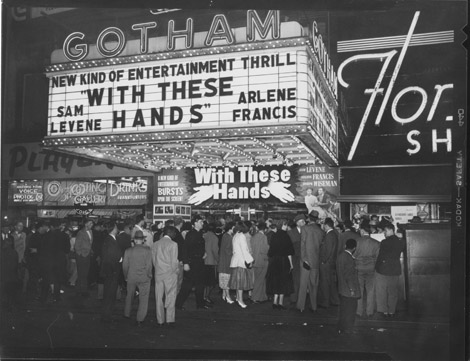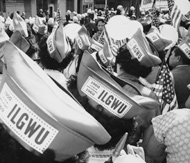

Highlights
Academy Award Nominated Film!

“Academy Award Nominated!” “Internationally Acclaimed!” “Beloved by Audiences!”
The headlines and reviews enthusiastically lauded the International Ladies’ Garment Workers’ Union (ILGWU) 1950 film “With These Hands” with praises not normally associated with a motion picture produced by a labor union. Through its history, the ILGWU knew the importance and benefits of utilizing entertainment and media to spread their message. The union owned FM radio stations, produced radio programs, sponsored paid television broadcasts, and ran advertisements in newspapers. Surprisingly, the union even had success in the field of Broadway with the popular 1937 show “Pins & Needles,” which featured a cast of garment workers and became a hit with critics and audiences. Hollywood and a foray into motion pictures soon beckoned the union. Previous attempts by other labor unions to create institutional films tended to be amateurish and propaganda that would not draw large crowds outside the intended audience of union members.
The ILGWU and President David Dubinsky wanted to change the perception of labor films and try the impossible—to create a movie that celebrated the first fifty years of the union while providing genuine entertainment and appealing to the general public. To ensure a professional production, the union secured veterans in the entertainment industry, and Jack Arnold and Lee Goodman were hired to direct and produce a story written by Morton Wishengrad. Arnold would later go on to become a famous science fiction director of such movies as “It Came from Outer Space” and “Creature From the Black Lagoon,” as well as television episodes of “Gilligan’s Island,” “The Brady Bunch,” and “The Love Boat.” Well known stage and Broadway actors were also hired to perform the lead roles in the film. Sam Levene plays the main character Alexander Brody. Levene started in Hollywood in the 1930s, starring alongside William Powell and Myrna Loy in the “Thin Man” movies, and he had a successful career on Broadway as well, originating the role of Nathan Detroit in “Guys and Dolls.” Other members of the cast include stage and screen actress Arlene Francis who may be best remembered as a panelist on the long running television game show “What’s My Line,” and Joseph Wiseman, who found fame as James Bond’s first villain, the iconic Dr. No. The pedigree of the individuals associated with the movie helped to establish “With These Hands” as anything but a traditional labor film.
“With These Hands” premiered on June 15, 1950 at the Gotham Theatre in New York City and played for a full month. The film performed even better outside of New York where attendance had only been average. The Education Department of the ILGWU maintained prints that were rented out, and locals, departments, and other unions and organizations purchased copies for viewing. It continued to draw audiences across the country and was very much in demand playing for union members in local theaters and for students at colleges and universities. At a one hour running time, the ILGWU particularly promoted the film to educators and history teachers, as well as trade union members at meetings and conventions. Following the film, discussions often arose around such topics as industrial relations, economics, history, and labor issues.
By 1951, the movie was playing internationally in the Netherlands, Italy, Belgium, Sweden, Denmark, Norway, Austria, Germany, England, France, Greece, and Canada, through cooperation with the U.S. State Department and Embassies and the United States Information Service and Economic Cooperation Administration. It was well received and supported by trade unions in the other countries. The movie later found an additional audience when it was shown on local television affiliates across the country. “With These Hands” received the ultimate compliment from the entertainment industry with a nomination in 1951 for an Academy Award for Best Documentary (Feature), though it lost to “The Titan: Story of Michelangelo.”
Despite its popularity, “With These Hands” did receive some criticism. There were complaints regarding the depiction of Jews in the film, mainly the portrayal of the bosses in the factories even though the workers were also Jewish. The majority of the requests for censorship originated internationally in the foreign markets and the main objections were the references to Communism in the film. “With These Hands” was banned in India after being shown for five years to much popularity, Yugoslavia refused to show the movie, and there were mixed reviews from both the Communists and anti-Communists in Italy. Ultimately, the film was well received from many different and diverse communities.
“With These Hands” opens with the main character, Alexander Brody, turning 65 and applying for retirement benefits under the Union Pension Fund. Brody begins to reflect on his life in the garment industry and union, taking the audience back to 1910 when he was a cloak operator in a small sweatshop and joining the ILGWU. The early days of the garment industry are visually documented by the crowded tenements, the horrible working conditions of 14 hour days in the cramped sweatshops, and the employees toiling under abusive bosses without any job security. Brody questions the policies in the shop when his boss unjustly fines another worker and he is quickly dismissed from his job, packing up his sewing machine and leaving the factory. He attends meetings of the ILGWU and participates in the Cloakmaker’s Strike of 1910. The general strike began on July 7, 1910 and workers stopped, left their jobs and began filling the streets. At its height, some 40,000 men and 10,000 women were involved to protest the low wages, long hours, and late nights and weekends sewing bundles at home. To help finance the strike, the film shows the union members and their families giving up jewelry, watches and valuables, as well as the hard times the unemployed workers like Brody experienced on the picket lines and the sacrifices their families made at home. After 58 days on strike, the union won recognition and Brody and his fellow garment workers were back in the shops under better working conditions.
“With These Hands” continues to illustrate historical events, providing a dramatization of the March 25, 1911 Triangle Factory Fire tragedy in which the women workers found themselves locked in the shop when a fire broke out resulting in the deaths of 146 young girls. The fire prompted new safety laws and legislation. The film continues to take the viewer through the first fifty years of the union and the changes in the industry visually illustrating the strike of 1926, the rise of Communism within the ranks and the union’s reaction, the effect of the Great Depression and the emergence of the Blue Eagle label of the National Recovery Administration (NRA) codes. As the events unfold, Brody works his way through the ranks of the union. Organizing efforts spread to small towns across the country and the membership increases. As the union continues to thrive and flourish, Brody’s working and living conditions also continue to improve as well, as he moves from a tiny tenement in the beginning of the movie to a well-appointed apartment in the end.
The film details the gains made by the union through contract negotiations showing how piece rates are settled and disputes resolved through arbitration under the collective bargaining agreement. Brody’s involvement in various union activities illustrates the wide range of benefits that the union offered; the Education Department’s art and music classes and the ILGWU Officer Qualification courses, vacations with pay and the union’s summer resort Unity House, and medical care provided at the Union Health Center. Throughout the film, Brody marvels at the journey of the ILGWU and its members and how far his hands have taken him since he started in 1910.
Selected Bibliography
5780 AV
The collection includes a VHS version and 16 mm print of “With These Hands.”
5780 F Motion Picture Films
The collection consists of 35 mm reel prints of “With These Hands” including foreign language versions, as well as a digitized version of the film on DVD.
5780 P Photographs
Available are photographs of still shots from the documentary “With These Hands,” as well as behind the scenes images during filming including actors on the set between takes, recording sessions, setting up scenes, and the crew and directors behind the cameras. The collection also contains negatives.
5780 PUBS Publications
The collection contains program booklets for “With These Hands,” as well as a ploy synopsis flyer to advertise the film. Also included are overseas reports and a plot book with script, scene descriptions and directions, and music and sound cues.
5780/002 David Dubinsky Correspondence
The collection includes correspondence regarding the opening of the film “With These Hands,” as well as programs and articles, invitations to the premiere at the Gotham Theater in New York City, and ticket counts and guest lists. With screenings across the U.S, there is numerous correspondence for requests for copies of prints for viewings and distribution from various labor unions, organizations, colleges and universities and departments and locals within the union. There are many letters commenting on the response and success of the film, applauding “With These Hands,” and the majority of the reviews were positive. But, there were a few instances where offense was taken regarding the depiction of Jews in the film and requests for censorship for references to Communism. Included are documents regarding ban in India after being shown for five years, refusal to show it in Yugoslavia, and reports of mixed reviews from Communists and anti-Communists in Italy. The collection provides information on the international screenings and programs in Chinese and the film in the Asian market. Also available are promotional material, posters for various television showings across the country, and dates and times for the local affiliate screenings.
5780/005 Frederick F. Umhey Correspondence
Included is correspondence regarding the copyright of the script for “With These Hands,” requests from individuals and organizations to receive copies of prints of the film. There are documents detailing the dates, times and local markets for showing the movie on television, as well as schedules. Also available in the collection are advertisements for “With These Hands,” consent forms for extras, records itemizing costs and fees for promotional material, and correspondence regarding international contracts and viewing.
5780/063 Legal Department Records
The collection includes the Motion Picture Agreement for copyright registration of “With These Hands” with the Library of Congress.
5780/090 P Central Pennsylvania District Photographs
The collection consists of a photograph showing a local theater running “With These Hands” with the film title on the marquee.
5780/109 Broadside Collection
Included in the collection are flyers with plot synopsis for “With These Hands” which acted as advertisements for television showings of the film on local channels in various cities.
5780/160 Scrapbooks
Within the collection is a scrapbook containing clippings of articles in English and Yiddish with reviews of “With These Hands” from newspapers across the country.
5780/166 PUBS Education Department Publications
The collection contains a plot synopsis flyer for “With These Hands.”
5780/183 AV Ohio-Kentucky Region AV Materials
The collection consists of a 16 mm print of “With These Hands.”
Under the Archives Tab on the menu at the left, view the photo gallery to see images of the film, behind the scenes shots, and the opening premiere!
Written and Compiled by Kathryn Dowgiewicz


